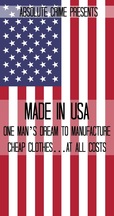Made In USA: One Man’s Dream to Manufacture Cheap Clothes…At All Costs

Kil Soo Lee was one of the most well-known garment makers because of his cheap price and quick turn around time--being from American Samoa was a nice touch because retailers could proudly stamp "Made In America" on his clothes. But Lee had a dirty secret to his success: he forced his workers into labor through deceit. Workers in his factory were prisoners, frequently abused for not working fast enough, starved and sometimes raped. Those who wanted to leave the compound could...for a price: they had to pay Lee $5000.
In this short book, go inside and learn how Lee's garment empire fell.
In this short book, go inside and learn how Lee's garment empire fell.
Buy Now!
Made In USA PDF and ePub |
Excerpt
PROLOGUE
‘Sweatshops’- it’s a word that conjures up dark images of small children sitting behind sewing machines, working long hours for very little pay, in dull and dirty factories. The word first originated in the mid 1800’s to describe just those conditions, at a time when these factories flourished in such places as Great Britian and New York City. These places earned the name ‘sweatshop’ for the brutally hot conditions under which the employees were forced to work.
Throughout the years, many tragedies occurred in these sweatshops, but probably none more tragic than the fire that struck the Triangle Shirtwaist Factory in New York City on March 25, 1911. The factory occupied the top three floors of a ten story building in Greenwich Village near Washington Square Park. On that March day, managers had locked the exits and stairwells to prevent the employees from taking unauthorized breaks. Around 4:30 in the afternoon, a fire broke out and quickly turned into a raging inferno. With the stairwells and exits blocked, workers could not get out of the building. When they realized they were trapped, many of them began jumping out of the top floor windows. By the time the fire was brought under control, a total of 146 people had perished.
The fire finally brought attention to the sweatshops operating in the city, and legislation was quickly passed to ensure better safety standards in the workplace. It was also this incident that led to the formation of International Ladies Garment Workers Union which continues to fight for better working conditions to this day.
Little by little things improved for immigrants coming to both America and Great Britain, and sweatshops eventually came to be a thing of the past, although this does not mean that they no longer exist in places such as the U.S. and the U.K.
The word sweatshop is defined as ‘working long hours for low pay in below standard conditions’ so technically, those wealthy residents who hire illegal aliens to work in their homes and fields, for less than minimum wage, could be said to be operating ‘sweatshops.’ Although most people don’t view them that way.
Those sweatshops that people envision when they hear the word do exist however, mostly in third world countries such as China, Vietnam and Thailand. Here, very young children, as well as men and women of all ages, are still employed to work long hours for extremely low pay.
It is an ongoing problem that most people attribute to nothing more than greed. But there are two views to every situation. While many support bringing an end to the sweatshops of the world, there are a surprising number of people who defend them. And they are not just the factory owners, but many of the people who work in them too.
Those who live in these third world countries toil long and hard anyway, and often for far less money than they can make in a sweatshop. In many respects, to lose these jobs in the factories would make their lives far more difficult.
For an American, to hear that a sweatshop worker was being paid .30 cents an hour for a 60 hour workweek, might sound like modern day slavery. But when one considers that the average pay for this same person in their own country is $1.00 a day, it doesn’t sound so bad to be making $3.00 a day in a sweatshop.
In 1993 Tom Harkin, an Iowa Senator, proposed banning imports from any country that used children in sweatshops. This may have seemed like a wonderful idea, but as a result of it, the country of Bangladesh laid off 50,000 children. And, according to Oxfam, a leading British charity, a large number of these children were forced to become prostitutes in order to earn a living and survive.
It is for just these reasons that many people from poor countries still accept jobs in factories they know will be labelled sweatshops. They’ve heard the horror stories, but they’re used to working long hours anyway, and for less pay, and in less than perfect conditions. They assume they might face harsher restrictions and less freedom, and they’re willing too. In truth, they firmly believe it won’t be all that much different from their current lives.
Of course, none of them had ever worked for Kil Soo Lee before, but that didn’t matter. They were certain he wasn’t operating a sweatshop anyway.
‘Sweatshops’- it’s a word that conjures up dark images of small children sitting behind sewing machines, working long hours for very little pay, in dull and dirty factories. The word first originated in the mid 1800’s to describe just those conditions, at a time when these factories flourished in such places as Great Britian and New York City. These places earned the name ‘sweatshop’ for the brutally hot conditions under which the employees were forced to work.
Throughout the years, many tragedies occurred in these sweatshops, but probably none more tragic than the fire that struck the Triangle Shirtwaist Factory in New York City on March 25, 1911. The factory occupied the top three floors of a ten story building in Greenwich Village near Washington Square Park. On that March day, managers had locked the exits and stairwells to prevent the employees from taking unauthorized breaks. Around 4:30 in the afternoon, a fire broke out and quickly turned into a raging inferno. With the stairwells and exits blocked, workers could not get out of the building. When they realized they were trapped, many of them began jumping out of the top floor windows. By the time the fire was brought under control, a total of 146 people had perished.
The fire finally brought attention to the sweatshops operating in the city, and legislation was quickly passed to ensure better safety standards in the workplace. It was also this incident that led to the formation of International Ladies Garment Workers Union which continues to fight for better working conditions to this day.
Little by little things improved for immigrants coming to both America and Great Britain, and sweatshops eventually came to be a thing of the past, although this does not mean that they no longer exist in places such as the U.S. and the U.K.
The word sweatshop is defined as ‘working long hours for low pay in below standard conditions’ so technically, those wealthy residents who hire illegal aliens to work in their homes and fields, for less than minimum wage, could be said to be operating ‘sweatshops.’ Although most people don’t view them that way.
Those sweatshops that people envision when they hear the word do exist however, mostly in third world countries such as China, Vietnam and Thailand. Here, very young children, as well as men and women of all ages, are still employed to work long hours for extremely low pay.
It is an ongoing problem that most people attribute to nothing more than greed. But there are two views to every situation. While many support bringing an end to the sweatshops of the world, there are a surprising number of people who defend them. And they are not just the factory owners, but many of the people who work in them too.
Those who live in these third world countries toil long and hard anyway, and often for far less money than they can make in a sweatshop. In many respects, to lose these jobs in the factories would make their lives far more difficult.
For an American, to hear that a sweatshop worker was being paid .30 cents an hour for a 60 hour workweek, might sound like modern day slavery. But when one considers that the average pay for this same person in their own country is $1.00 a day, it doesn’t sound so bad to be making $3.00 a day in a sweatshop.
In 1993 Tom Harkin, an Iowa Senator, proposed banning imports from any country that used children in sweatshops. This may have seemed like a wonderful idea, but as a result of it, the country of Bangladesh laid off 50,000 children. And, according to Oxfam, a leading British charity, a large number of these children were forced to become prostitutes in order to earn a living and survive.
It is for just these reasons that many people from poor countries still accept jobs in factories they know will be labelled sweatshops. They’ve heard the horror stories, but they’re used to working long hours anyway, and for less pay, and in less than perfect conditions. They assume they might face harsher restrictions and less freedom, and they’re willing too. In truth, they firmly believe it won’t be all that much different from their current lives.
Of course, none of them had ever worked for Kil Soo Lee before, but that didn’t matter. They were certain he wasn’t operating a sweatshop anyway.








